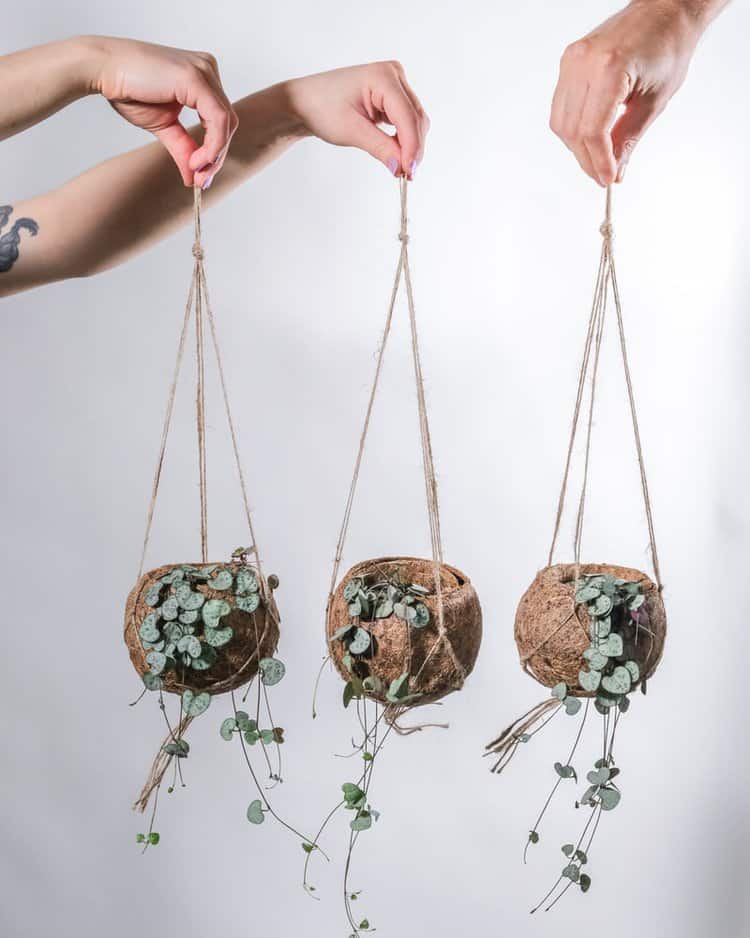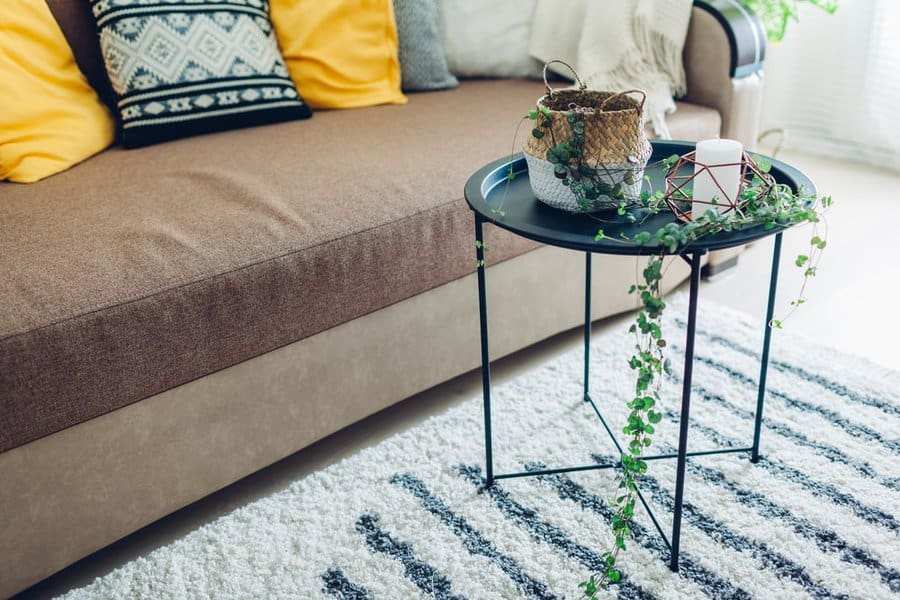If you love a succulent plant with a trailing vine, you’ll love the variegated silver markings on the String of Hearts plant. The heart-shaped leaves make it a great gift or beautiful addition to your indoor plant collection. It can also be grown outdoors.
Here’s everything you must know about caring for the String of Hearts plant.
Table of Contents
String Of Hearts Overview
The hearts plant is native to Southern Africa, Swaziland, and Zimbabwe. It comes from the Apocynaceae family and the ceropegia genus. Its botanical name is Ceropegia woodii.
The hearts plant has many common names, including rosary vine, sweetheart vine, collar of hearts, and chain of hearts.
The String of Hearts varieties include the String of Hearts Silver Glory, Orange River, and the Pink String of Hearts.
The Silver Glory plant has a rounded bottom and pointed ends. It gets its name from the leaves silver appearance, and the plant is very sensitive to light.
The Orange River String of Hearts plant earned its name from the orange undertones at the bottom of the leaves. The top of the leaves have a dull green or silvery appearance, but the plant is extremely easy to care for, making it a great addition to any garden.
The Pink String of Hearts plant has pink and white leaves. However, they are much more difficult to care for and are difficult to find. If you don’t take proper care of the Pink Hearts plant, it will permanently lose its variegated colors.
| Botanical Name | Ceropegia woodii |
| Family | Apocynaceae |
| Genus | Ceropegia |
| Origin | South Africa |
| Sunlight | Bright indirect light |
| Watering | Only when dry |
| Soil | Well-draining |
| Temperature | 60 – 80 degrees |
| Propagation | Stem cuttings |
| Re-Potting | Re-pot often to avoid overgrowth |
| Pests and Diseases | Fungus gnats |
| Toxicity | Not toxic |
String Of Hearts Features
The String of Hearts plant grows to approximately 2 – 5 cm tall and 2 – 4 cm wide but can trail as long as 10 feet when grown in the right conditions outdoors. They can get up to one foot long if you grow them as house plants. They bloom in the summer and fall, randomly blossoming flowers with a white to pale pink tubular corolla and five purple petals.
The plant’s stems are very fragile, and leaves grow about an inch apart. Since it’s a trailing vine, the leaves often get tangled, but the plant still looks beautiful.

String Of Hearts Care Guide
Caring for the String of Hearts plant is easy for beginners and experts, making it a great addition to any home or garden.
Ideal Growing Place
You can grow String of Hearts plants indoors and outdoors; however, it doesn’t tolerate cold temperatures. If you keep it outdoors, ensure it’s in a pot that you can bring in if your area experiences cold temperatures or frost.
Water
The nice thing about the Rosary Vine is it likes its soil dry. So, it’s best to wait for dry soil before watering it again. Indoors, you can usually go a week or two without watering it. But, if you have it outdoors in higher temperatures, it may need more frequent watering, but avoid extremely wet soil.
To determine if it needs watering, stick your finger in the soil. It should come out completely dry before watering it again.
Sunlight
The String of Hearts plant likes bright indirect sunlight. It needs the perfect amount of light to keep the color in its leaves. However, too much light can scorch the leaves, causing the plant to die.
The perfect amount of bright indirect light will produce a string of leaves about one inch apart. If you notice more space between your leaves, they might not receive enough light. If you don’t have a window that offers good indirect light, consider adding a plant lamp.
Temperature
The String of Hearts loves warm temperatures thanks to its native habitat. It does best in temperatures between 60 and 80 degrees Fahrenheit. Anything below that could kill the plant.
If you live in an area where the temperatures get cool, it’s best to bring them indoors in the winter or before any frost threats.
Soil
The Heart of Strings grows best in a succulent mix that’s a well-draining soil. It shouldn’t retain too much water, so you can avoid root rot. To ensure the plant drains well, choose a pot with good drainage holes to increase its chance of survival.
Humidity
You don’t need high humidity levels for this plant; usually, 40 – 50% humidity is good. However, in their dormant phase, they don’t like a lot of humidity, so you don’t have to worry about it becoming too dry in the winter months.
Fertilizer
The String of Hearts plant doesn’t require much fertilizer. In fact, if you don’t fertilize it at all, it will survive. However, if you want it to produce more flowers, a houseplant fertilizer during its growing season can help. Fertilize it once in the spring and summer months, and your plant will produce more beautiful flowers.
Pinching/Pruning
Because this plant is a vining plant, it doesn’t require much pinching or pruning. As long as you give it ample room to grow and water it properly, you shouldn’t have to trim it. However, if you notice damaged or diseased leaves, consider cutting them off to avoid damage to the rest of the plant.
Potting and Re-potting
You may find yourself re-potting the Heart plant often because it grows fast. As soon as it outgrows its current pot, put it in a new pot at least two inches larger. This gives the plant more room to grow and the roots a better chance of remaining healthy.
Growth Zone
The String of Hearts plant grows best in USDA zones 9 – 12. You can grow it outdoors in other zones, but only during the spring and summer. Then, as the weather cools, bring the plant indoors until the winter weather passes.
You May Also Like: Lemon Coral Sedum: The Perfect Indoor & Outdoor Plant
Common Pests, Toxins, Diseases & Other Problems
The String of Hearts plant is easy to take care of, and it isn’t prone to too many pests or diseases.
The largest issue people have with the plant is with watering. If you overwater it, fungus gnats may congregate on the leaves. If you notice any pests on the plant, remove them from the leaves, clean the leaves with warm water in a spray bottle, and gently wipe any residue off.
An overwatered String of Hearts Plant may get root rot, putting the plant’s life at stake. Watering and light are the two most important factors to keep this plant looking its best.
Other common problems people experience with this plant are balancing watering and light. The leaves are the telltale sign when something is wrong. The leaves may appear yellow, crispy, or lose their green color. If this happens, reassess your plant care and see what changes you should make.
How to Propagate String of Hearts
It’s easy to learn how to propagate String of Hearts plants with these steps, using either the soil, water and tuber propagation method.
With water propagation, start by cutting a six-inch section of the vine off, but be careful as the stems are fragile. Next, remove the leaves from the bottom few inches, so you have a bare stem, and place the stem cutting in water and indirect light. The roots will grow within a week or two.
You can also use the soil propagation method. Using the same stem cutting, you can plant it in well-draining soil, keeping it moist and ensuring it gets plenty of indirect light.
With the tuber method, after the plant flowers, you will start to see bead-like aerial tubers growing on the vine. When these nodules touch soil, they will begin to take root. Trim the vine that has the tuber attached and place the cutting on top of soil in a new pot. Keep it in a bright area and water weekly. It will start rooting in a few weeks.
String Of Hearts Mature Timeline
The String of Hearts plant grows quickly, with roots taking shape within a week or so. So it shouldn’t take long whether you propagate in soil or water.

String Of Hearts FAQ
Where to Buy String of Hearts Plant?
You can find the String of Hearts plant at your local big box stores or online on sites like Etsy or specialty nurseries. Because they propagate so easily, many people sell them. However, once you have one plant, you can propagate your own, creating as many plants as you want.
How Old Does String Of Hearts Have To Be Before They Bloom?
Most succulent plants don’t bloom until they are fully mature, which takes four to six years. However, it’s worth the wait because the String of Hearts flowers are gorgeous and last approximately six weeks from spring to summer.
How Fast Does String Of Hearts Grow?
The String of Heart plant grows fast. When you propagate them, the roots take only a week to grow and stabilize, and the plant takes off from there, growing incredibly fast.
Are All String Of Hearts Variegated?
The original String of Hearts plant isn’t variegated. Instead, it has rich, dark green leaves, whereas the variegated String of Hearts plants has various colors, including silver and pink.
Is The Chain Of Hearts Plant Rare?
The chain of hearts plant is rare and makes a wonderful addition to your plant collection when found.
Is Propagating String Of Hearts Easy?
It’s easy to propagate the String of Hearts plant, and you can use one of two propagation methods, including the water or soil propagation method. Both offer fast-growing roots and beautiful plants in a short time.
Why Are My String Of Hearts Leaves Curling?
Curling leaves are usually a sign of too much water or sunlight. Consider how you’re caring for your plant. If it’s in bright light, move it. The plant does not like direct sun. If it’s not getting enough light, change its location without giving it too much light. If you’re overwatering it, cut back on the watering frequency, or if you’re not watering it enough, increase how often you water.
Are String Of Hearts Succulents?
The String of Hearts isn’t necessarily a succulent, but it has similar characteristics, including the need for infrequent watering.
Will String of Hearts Climb?
The String of Hearts does better as a trailing plant versus climbing. So it’s best to make it a hanging plant and let gravity do its job.
Should You Untangle String of Hearts?
It’s best to leave the String of Hearts stems as is if you can. Because the stems are so fragile, you risk breaking the plant if you try to untangle them.
What Is The String Of Hearts Butterfly Method?
The String of Hearts plant grows in pairs. Therefore, there will be a pair of leaves on each side of the stem. To use the butterfly method, cut about 1/8 of an inch above each leaf to propagate it.
What Do Underwatered String Of Hearts Plants Look Like?
Underwatered String of Hearts leaves get crunchy or turn yellow. If you aren’t sure if that’s the problem, stick your finger in the soil. If it’s excessively dry, you might not be watering the plant enough.
What Is The Difference Between String Of Turtles Vs. String Of Hearts?
At first glance, the String of Turtles and String of Hearts look very similar as they both have variegated leaves. However, the leaves on the heart plant are shaped like hearts, and the turtle plant’s leaves are round.
What Is The Difference Between Silver Glory String Of Hearts Vs. Regular?
The Silver Glory leaves have a silver tint, especially when they get adequate light. The regular leaves are darker green and don’t have any color variation.
What Kind of Pot Is Suitable For a String Of Hearts?
The most important factor for the plant’s pot is its size. Because the String of Hearts grows so fast, it needs a pot that’s at least two inches larger than it needs to allow room for growth.
Is String of Hearts Poisonous?
The String of Hearts plant isn’t toxic to humans or animals; however, medical attention should be sought if anyone ingests them.
The Bottom Line
If you’re looking for a beautiful addition to your plant collection or garden, check out the String of Hearts plant. It loves bright indirect light and doesn’t require frequent watering, which makes it a perfect plant for beginners. With a simple propagation method, you can make new plants easily as gifts for others.
Last Updated on October 10, 2022 by Gustaf Johansson




